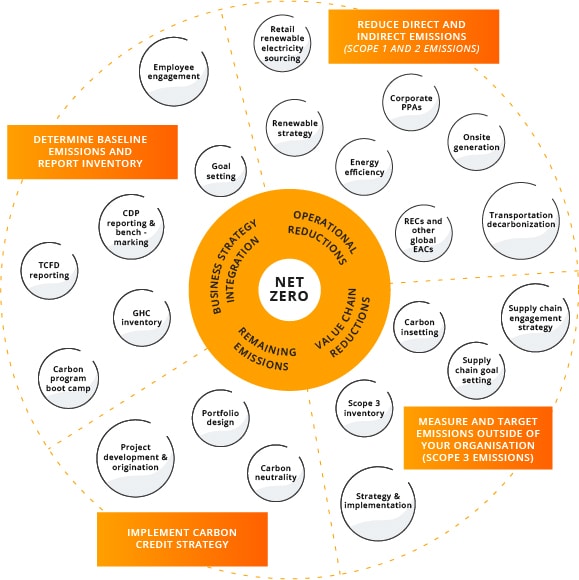
How to become zero carbon? Handy tips
Going green is no longer a fashionable trend or a whim of huge companies. It’s a matter of business strategy that must follow national and international green regulations. What’s crucial, implementing green actions in the long-term company's development plan is what we need to do for the planet. Time is running out, so let’s act wisely.
Green actions, eco-awareness, sustainability, becoming carbon neutral, zero-carbon or net-zero – these ideas are regarded as significant elements of a successful business strategy for at least several reasons.
Several reasons to go green
First and foremost, businesses from small startups to giant corporations are obliged to follow specific rules and strategies in environmental care.
Europe can become the first climate-neutral continent, resulting in a cleaner environment, more affordable energy, more intelligent transport, new jobs, and better quality of life. These goals can only be achieved when all organisations and businesses include green actions in their long-term strategies.
To make things easier to understand, let’s sum up a few essential terms via “Plan A”:
- Carbon neutral means that any CO2 released into the atmosphere from a company’s activities is balanced by an equivalent amount being removed.
- Climate positive means that activity goes beyond achieving net-zero carbon emissions to create an environmental benefit by removing additional carbon dioxide from the atmosphere.
- Carbon negative means the same thing as “climate positive.”
- Carbon positive is how organisations describe climate positive and carbon negative. It’s mainly a marketing term, and understandably confusing–we generally avoid it.
- Climate Neutral refers to reducing all GHG to the point of zero while eliminating all other negative environmental impacts that an organisation may cause.
- Net-Zero carbon emissions mean that an activity releases net-zero carbon emissions into the atmosphere.
- Net-Zero emissions balance the whole amount of greenhouse gas (GHG) released and the amount removed from the atmosphere.
But rules and laws are not the only reasons why various companies worldwide decide to go green on many levels. Decision-makers search for ways of being one step ahead of their companies’ competition in terms of sustainability. Going green is also extremely important from the PR perspective as more customers, users, potential business partners, and suppliers choose visibly sustainable and responsible companies with their green policies.
Benefits of going green as a business
There are plenty of positive outcomes of taking environmental actions on a business level. These are the most significant ones:
Legal and regulatory compliance
Companies that include eco-awareness in their long term strategies adapt easier and faster to green laws on local, state, EU or even global levels. It shows how business understands that going green is crucial for the Earth’s ecology and helps get a few steps ahead of the less aware competition. Reducing carbon emissions, promoting sustainability, and searching for new ways of going green in business is a proactive attitude that pays off now and will become a must-do soon.
Efficiency increases savings
The fact is that increasing energy efficiency saves on utility costs. Reusing existing materials in new ways means less money is spent purchasing new stock to create products. Streamlining transportation of employees or shipping saves the Earth as well as a substantial amount of money. Of course, companies need to plan some expenses on establishing green business procedures, but in the long run, they always count.
Green marketing helps win people
Many different surveys show that consumers around the globe (especially Millennials) are ready to pay more for a product or service coming from sustainable sources. Green businesses show their customers, suppliers and business partners that sustainability is not just a one-minute whim or PR trick but a significant part of their mission and company culture. It’s vital to be honest and consistent in green actions. Plenty of customers and business partners are highly sensitive to scams or greenwashing, which is unforgivable and always causes tremendous image losses.
Impact on employee morale
Employees in green businesses feel safer at work, have more positive feelings and trust for their companies. What is more, involving workers in company-wide green initiatives boosts morale. People feel that their health and future matter, and they want to go green. Not many employers realise that sustainability is a crucial factor in reducing turnover, as employees want to stay in a place where they are part of a work community that cares.
Becoming a go green icon
Nowadays, to become an environmentally friendly company means gaining wide and high esteem, even a status symbol. Many eco-aware actions are promoted by companies like Dell (with their free electronics recycling programme) or Toyota (known as one of the greenest businesses in the automotive branch, famous for its lean management idea, hybrid technology or hydrogen engines). The greener company becomes, the more positive buzz it generates. For many eco-aware consumers, companies like these listed before are icons and benchmarks for others.
What can a business do for the climate?
There are essential steps that companies can take on many levels to reach compliance with the green laws and become more sustainable. These ideas include, for example:
- Step 1 – Including green actions in business strategy
Going green starts with a detailed plan that needs to fit with other business goals and long-term visions.- Benchmarking competitive actions and goals (What are the best practices other companies present regarding net-zero plans? How do your organisation’s climate actions stack up?)
- Climate reporting and disclosures (Climate risk assessment and disclosure to investors)
- Pointing customers’ and other stakeholders’ expectations (e.g. topics such as definitions of common climate commitments, high watermark activities of leaders, a crash course in greenhouse gas accounting and identification of your organisation’s climate risks and opportunities)
- Annual emissions inventory (Important data about key emissions hotspots is required to set a meaningful strategy)
- Benchmarking competitive actions and goals (What are the best practices other companies present regarding net-zero plans? How do your organisation’s climate actions stack up?)
- Step 2 – Planning operational reductions
These include electricity purchased to operate offices, databases and manufacturing facilities and direct burning of fossil fuels. Companies can get involved in energy efficiency projects, rooftop solar installation, using renewable energy or switching to cloud solutions to store data or operate specific tasks. - Step 3 – Reducing value chain costs
Usually, supply chain emissions within the value chain represent the most significant share of a company’s emissions footprint. A thorough hotspot analysis and a cycle analysis helps map all sources of emissions. Then it’s time to develop a strategy to engage suppliers in carbon reduction initiatives, such as converting to renewable energy use. - Step 4 – Managing remaining emissions
It’s also good to have a plan for the emissions that remain after all other internal reduction measures have been implemented. A company can begin to integrate investments in carbon removal projects alongside carbon avoidance projects. It would be an essential tool in guiding the business along the path towards longer-term climate goals.
Let’s workshop, going green pays off
The time and resources required to establish new environmentally green protocols pay back over the years, not only in money but also in feeling that the company truly serves the planet.
If you wonder how your company’s IT strategy can be enriched with long-term green and sustainable actions, see strategy workshops in the Future Processing’s offer. We will explore the current state and work out the best solutions for your business and the environment. Our workshops are helpful when you have an already existing IT structure, as well as when you start to build the whole system from scratch.





